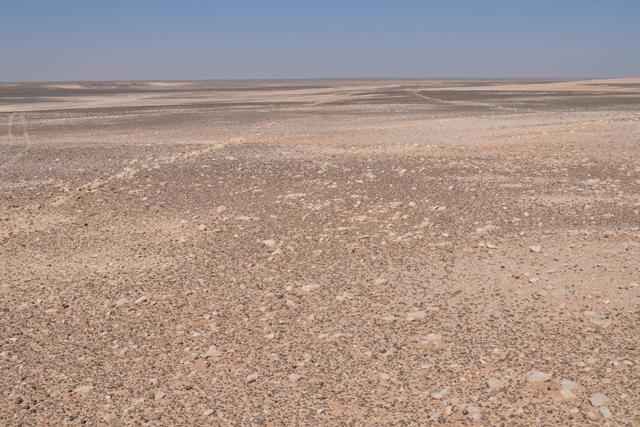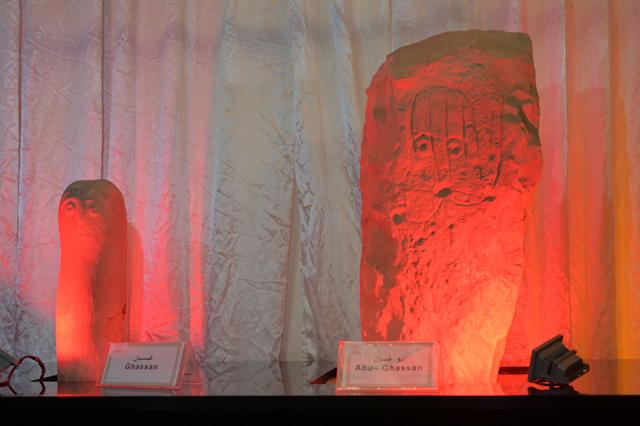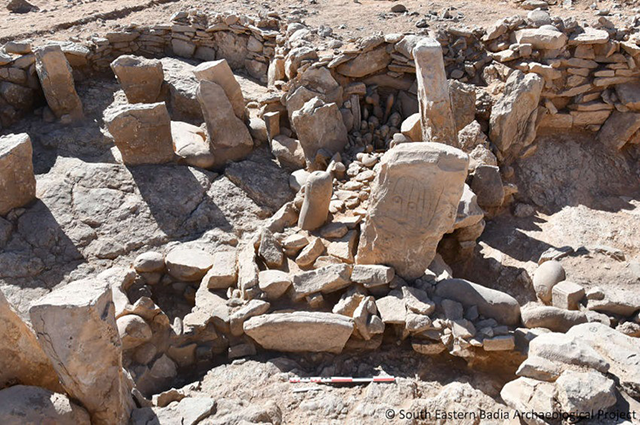You are here
Kites of Jibal Khashabiyeh: delving into Neolithic geology
By Saeb Rawashdeh - Apr 05,2024 - Last updated at Apr 05,2024

A field work at Jibal Al Khashabiyeh (Photo courtesy of the South-Eastern Badia Archaeological Project)
AMMAN — Al Jafr is a town located near Maan, in the south-eastern region of Jordan, within the area of Jibal Khashabiyeh. Approximately 80 kilometres east of Al Jafr lies a remote and unpopulated part of the country.
The geology of this desert region is composed of chert bedded limestone and marl (Eocene-Paleocene) in the northern and eastern areas, while the largest sector of the region, stretching from the northwest to southeast, is characterised by chalk marl, bituminous limestone and marl, known as the Muwaqqar Chalk-Marl Formation. In the southwest, the landscape features sandy and silicified phosphorites and marly limestones, along with locally recent Quaternary deposits, such as alluvial sediments or aeolian sands in wadi beds.
The archaeology team excavated eight kites (prehistoric traps/enclosures) in Jibal Khashabiyeh. The kites, which form a continuous chain in the desert regions of the Near East, were used in Armenia and Central Asia.
“Three of these eight kites present a well-conserved enclosure. The excavations focused on the three best-preserved kite enclosures. The circular structures at the periphery of the enclosures were excavated. These were identified as pit-traps, which likely served as mechanisms for capturing hunted animals, as observed during excavations of other kites across various regions of Jordan, the Middle East, the Caucasus and Central Asia,” the French anthropologist René Crassard said.
In parallel with excavation operations, a comprehensive survey of the entire Jibal Khashabiyeh sector was conducted in order to complete the archaeological map of the area, and also to carry out a study of the present-day environment (geology, topography, hydrography, flora).
Finally, an ethnographic survey was initiated, based on interviews with the Bedouin populations inhabiting the area. This effort aimed to gather information on the nomadic pastoral way of life, said Wael Abu Azizieh from the French institute Ifpo.
After conducting several tests, archaeologists discovered evidence indicating that the site had been looted multiple times. However, abundant lithic industries were found, attesting to the occupation of the site during the Pre-Pottery Neolithic B.
Also, “numerous fireplaces, accompanied by relatively large quantities of burnt animal bones, mostly from gazelles, were found”, Abu Azizeh said.
“The radiocarbon dating of charcoal samples confirms that this occupation corresponds to a Late/Final PPNB context, strictly contemporaneous with the use of kites around 7,000 BC,” Cressard said, adding that the relatively simple organisation of the structural remains suggests the potential for seasonal occupations of these dwelling sites by hunters. One of the excavated sites there proved to be more complex.
“It provided lithic tools, grinding and crushing equipment, ornamental objects, various figurines, which is unusual in a desert occupation context,” noted Abu Azizieh, emphasising that it also yielded an exceptional quantity of faunal remains, composed of more than 99 per cent of gazelle remains.
The site showed evidence of an industrialised (though primitive compared to modern times) site for hunting exploitation, with clear indications of butchery activities occurring on-site.
“The local populations call the region of Jibal Khashabiyeh “Ardh as-Suwan”, which translates to ‘flint (chert) land’ or territory,” noted Mohammad Tarawneh from Al Hussein Bin Talal University. He added that chert is omnipresent in the landscape and outcrops on the surface of the plateau, in escarpment sections, or in the eroded bottoms of certain wadis.
On the dwelling sites tools on unipolar blades, small blades in fine-grained flint and quartzite, arrowheads, bifaces, curved maces show that the area was a hunting hub.
“A significant portion of the lithic industry described here was undoubtedly designed for use in hunting activities and the processing of animal resources,” Tarawneh elaborated. He further explained that the abundance of flint in its natural state adjacent to the site provides the most logical explanation. These flints are generally of high quality and the plates, platelets and nodules used are propitious to the production of relatively large blades.
“The rather expeditious aspect of the laminar and bladelet operational schemes can be explained by raw material abundance immediately beside the site, allowing for large-scale lithic production, the use of blanks in a short period of time, and the possibility of cutting and scraping with non-transformed blanks for limited use,” Tarawneh underscored.
The production of small blades from red orthoquartzite naviform cores, such as those at Jibal Khashabiyeh, is known at other Late PPNB sites, such as Ain Jamman , for example, Tarawneh emphasised, adding that the association of the same types of arrowheads as those found at Jibal Khashabiyeh with bifacial pieces is comparable to that observed at the Sha‘ar Hagolan site as well as at sites related to the Tuwailan in the Naqab Desert.
“Chronologically, and technologically speaking, Ghassanian lithic industries are part of a transitional context between the Late and Final PPNB. In future studies, it will be important to make more detailed comparisons with contemporaneous sites in the Southern Levant to identify possible similarities with the large contemporaneous sedentary villages and possible direct contacts or relationships between nomadic kite hunters and the sedentary populations of the more humid regions on either side of the Jordan Valley,” Tarawneh underlined.
Related Articles
AMMAN — In early 2022, eight dwelling sites were discovered in south-eastern Jordan, directly associated with eight mass-hunting structures-
AMMAN — Minister of Tourism and Antiquities Nayef Al Fayez on Tuesday announced the discovery of a "unique ritual installation" dedicated to
AMMAN — A research in the south-eastern desert began in 2013 when the “South Eastern Badia Archaeological Project” was established.In a remo














